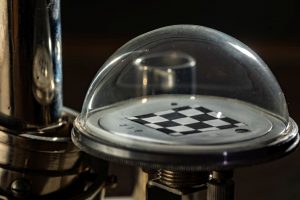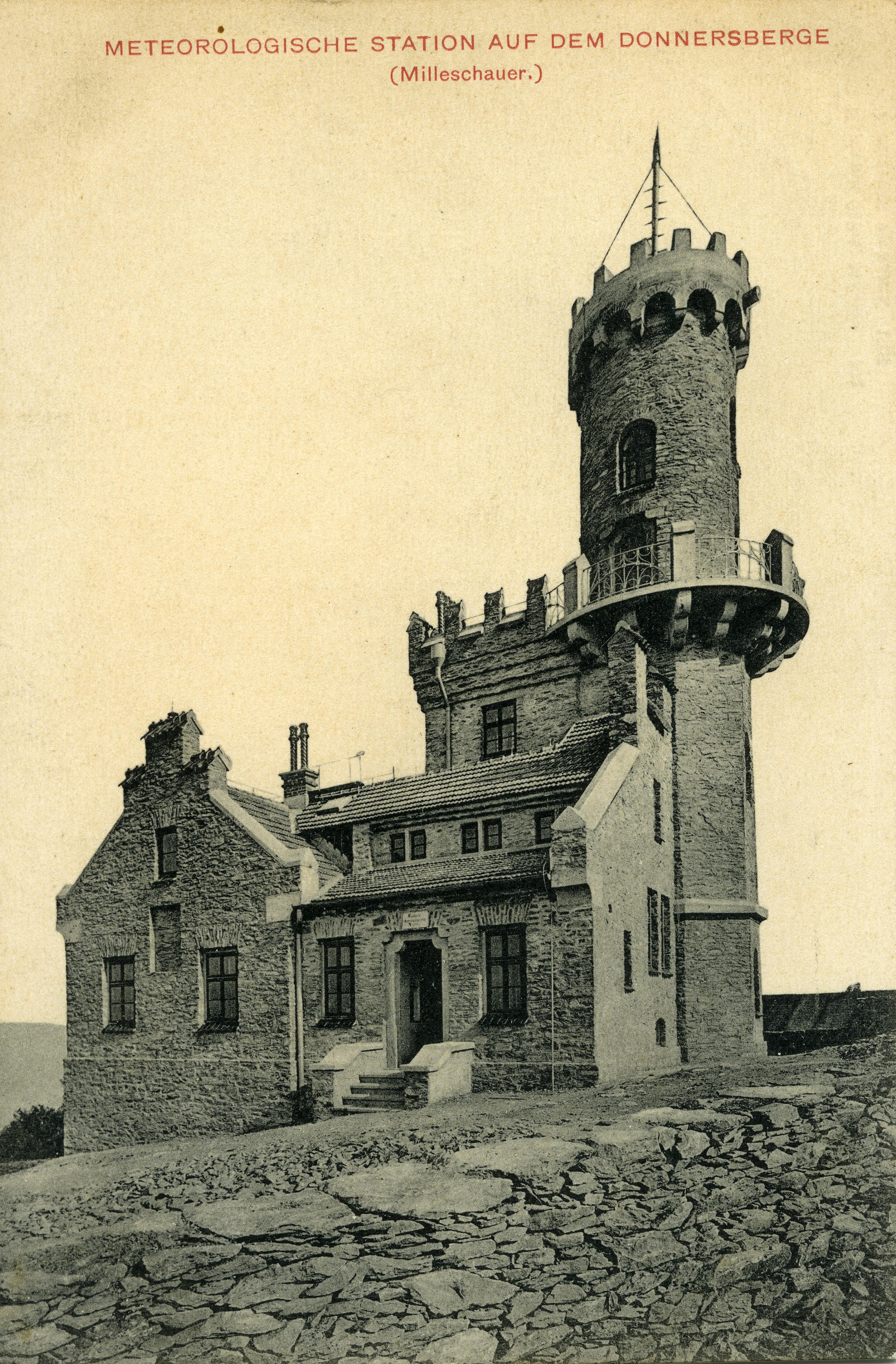March
| Historical pyranometer for measuring global solar radiation by differential heating of white and black surfaces that reflect and absorb the radiation, respectively. |  |
| Pyranometers are used to measure global solar radiation, most often on the thermoelectric principle. Their differential thermocouple, or thermobattery, indicates the temperature difference between a surface that absorbs almost completely the incident shortwave radiation and a surface that does not absorb the radiation or is shielded. A similar temperature difference is determined by the differential bimetal in a Robitzsch bimetallic pyranograph or by the temperature difference on the thermometers of an Arago-Davy pyranometer. Some types of pyranometers use photodiodes as sensors, which generate a photoelectric voltage proportional to the incident radiation. A distillation pyranometer or lucimeter measures global or circglobal radiation by using the radiation absorbed by the instrument's sensor to vaporize a suitable liquid, the volume of which, after recondensation, is a measure of the absorbed radiation. If direct solar radiation is removed by a shield, pyranometers measure the scattered solar radiation and operate as diffusometers. Pyranometers are usually fitted with two glass hemispheres to protect their sensors from the disturbing effects of wind, precipitation, internal air circulation within the sensor and from the deposition of dust and dirt. The hemispheres also prevent the passage of radiation of longer wavelengths than about 4 µm and cause the pyranometer to measure only short-wave radiation. If the pyranometer is exposed to hemispheres that allow the passage of long-wave radiation, i.e. it measures both short-wave and long-wave radiation, it is called a pyrradiometer. | |
 The first important building that was built at Milešovka was a small pub, which was built in 1820 under very difficult conditions by the innkeeper Anton Weber from Velemín. In the following years, he gradually expanded the pub into 2 dining rooms, several cottages, a dance area, a small shop and a chapel. In the 1840s he built a 4 m high stone lookout tower on Milešovka.
The first important building that was built at Milešovka was a small pub, which was built in 1820 under very difficult conditions by the innkeeper Anton Weber from Velemín. In the following years, he gradually expanded the pub into 2 dining rooms, several cottages, a dance area, a small shop and a chapel. In the 1840s he built a 4 m high stone lookout tower on Milešovka.
The observatory was built on the initiative of Reginald Czermack-Warteck, the then commercial councillor, who was a deserved member of the presidium of the Mountain Association in Teplice and the chairman of the mountain associations of Northwest Bohemia. Several committees were set up to carry out the construction of the observatory, the scientific committee being headed by the university professor Dr. R. Spitaler. From five projects submitted by different architects, the design of E. Hoke.
Construction of the observatory began on 4 March 1903. The basic building material was phonolite, which was quarried directly on the top of Milešovka. The construction was completed in June 1904. The observatory building includes an 18 m high tower with a 10 m high viewing gallery.
Since 1905, meteorological observations and measurements have been carried out here continuously (with a small break in 1917 and during World War II).
In 1953, the observatory came under the administration of the Czechoslovak Academy of Sciences (CSAV), first under the Geophysical Institute, then under the Meteorology Laboratory of the Institute of Meteorology and finally in 1964 under the Institute of Atmospheric Physics, to which it belongs to the present day.
Nowadays, the observatory is included in the international network of synoptic stations and standard meteorological observations are carried out every hour. In addition, the observatory is equipped with a number of special meteorological instruments.

Zdroj: wikipedia.org
Vilhelm Bjerknes (14 March 1862 – 9 April 1951) was a Norwegian physicist and meteorologist. In 1917 he founded the Geophysical Institute in Bergen, where he gathered a number of collaborators, the so-called Norwegian Meteorological School. Together they enriched synoptic meteorology with the concept of air masses and their interfaces, i.e. atmospheric fronts. They successfully used their knowledge in weather forecasting, which consisted of estimating the evolution of the thermobaric field. Bjerknes applied his knowledge of hydrodynamics and thermodynamics to the atmosphere; he described the processes in the atmosphere using the so-called primitive or fundamental equations, opening the door to later numerical weather prediction.
World Water Day is an annual United Nations (UN) observance day held on 22 March since 1993. It highlights the importance of fresh water and promotes the responsible use of water and access to safe water for everyone. World Water Day highlights the essential role water plays in our lives and how we can better protect it.
World Meteorological Day was established in 1951 to commemorate the establishment of the World Meteorological Organization on 23 March 1950. This organization announces a slogan for World Meteorological Day every year, and this day is celebrated in all member countries. For example, in 2023, the theme of World Meteorological Day was The Future of Weather, Climate and Water Across Generations.
Josef Podzimek (24th March 1923 - 25th December 2007) studied applied physics and mathematics at the Faculty of Science of Charles University. During his military service at the Prague-Kbely airport he became acquainted with cloud microphysics, which he has been working on throughout his scientific career. He combined both experimental and theoretical components of his research work. In 1954 he joined the Geophysical Institute of the Czechoslovak Academy of Sciences as head of the cloud physics department in Hradec Králové. Since then he has contributed to dozens of articles in renowned international journals. Already in 1959 he published a comprehensive monograph, Physics of Clouds and Precipitation.
The aforementioned department became part of the Meteorology Laboratory of the Czechoslovak Academy of Sciences, established in 1961, and later the Institute of Atmospheric Physics of the Czechoslovak Academy of Sciences, established in 1964. Josef Podzimek became the first director of the IAP, and at the same time he was an external lecturer at the Faculty of Mathematics and Physics of Charles University, where he was habilitated in 1967. In 1970 he decided to stay in the USA, where he worked as a researcher and professor at the University of Missouri-Rolla until 1992. Almost until his death, he was scientifically active, and after the change of political circumstances, he also collaborated with the staff of the IAP.
